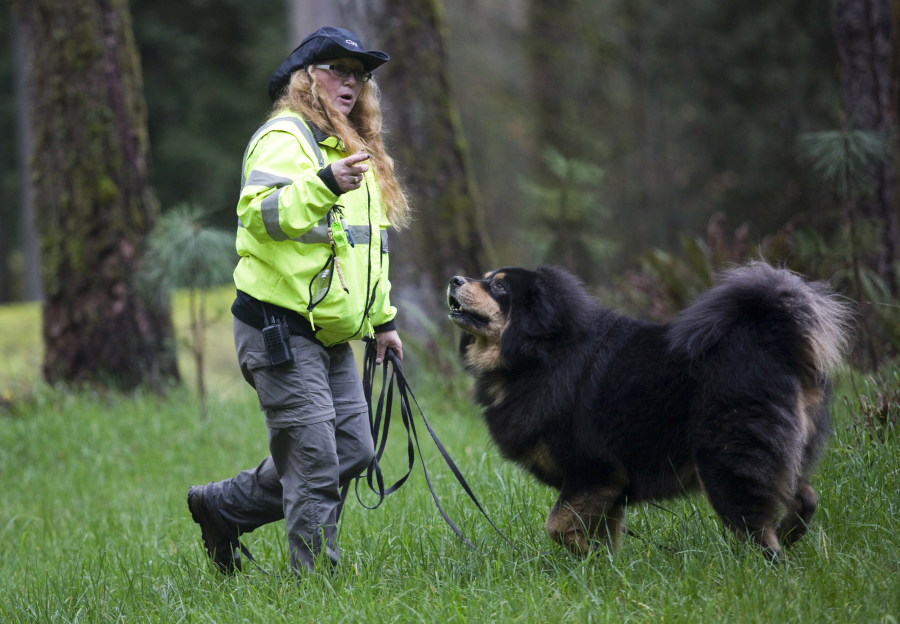BATTLE GROUND — Tibetan mastiff Dusty, showing off his skills at finding human remains, pawed a patch of dirt Saturday afternoon at Camp Hope. Paydirt.
Her handler, Brenda Wilson, planted some practice remains around the camp area for practice, and Dusty got a hot dog slice for his effort.
The dogs were bred as guard dogs — “He wipes out the coyote population that comes in and tries to kill my animals, so he does his job at home,” said Wilson, who volunteers with Evergreen Search Dogs — but he’s also trained as a search and rescue dog.
Wilson, Dusty and search and rescue volunteers from around the county, and their dogs, gathered north of Battle Ground over the weekend for a training campout.
Evergreen Search Dogs, a volunteer search and rescue organization based in Clark County that specializes in providing working dogs, hosted the three-day event. Roughly 25 people came to camp and practice.
Evergreen Search Dogs’ Zach Painter said a handful of volunteer search and rescue teams came, mostly from Clark County, with one from Snohomish County. About 25 people came out.
The weekend offered training for typical search volunteers, and for dogs and their handlers.
“The dogs already know how to do what we want them to do,” said Painter, who brought his 8-month-old giant schnauzer, Freya. “They already know how to track something down, they already know how to use their nose — it’s just learning how to communicate with the dog.”
On Friday, the volunteers worked on using radios. On Saturday, they worked through some basic survival skill training, and navigation and maps.
The emergency agencies volunteer teams work with require volunteers stay certified in some core skills, and train regularly.
“We train again, over and over, because a lot of the skills are perishable,” said John Polos, who volunteers with Southwest Washington Search and Rescue.
Like most volunteer teams, his works on foot without animals. His team tries to practice once a month, he said.
“You always learn something. Unless you’ve forgotten that you’ve already learned it before,” he said, joking. “You learn how to help other people, to help with their skills.”
Many people who go into the working-dog side of search and rescue end up there because of their dogs, Painter said. Those people might know how to handle their dogs, but they might not have much experience hiking around or using a compass, so that kind of training is helpful for everyone.
Today, the volunteers’ agenda calls for practice organizing for larger incidents.
Painter said Evergreen’s services are called on about once a week, typically. In the fall, they tend to go out looking for missing mushroom pickers.
Search teams like his can end up getting called to anywhere in the state, he said, but one place they find themselves going to fairly often is the Gorge, he said.
That’s why, along with the radio practice, organizers also brought in a reptile expert Friday to help train the dogs on dealing with snakes.
The dogs learn to avoid rattlesnakes based on sound, sight and smell, Painter said, and with a very practical lesson.
The expert had a few leashed, de-venomed rattlesnakes tied to stakes. The expert and handler walk with the dog, holding two leashes, around a course. When the dogs get within striking distance of the snake, it gets a zap from a shock collar.
“It’s not awesome, because you have to shock your dog, but it builds a negative association with the snake,” Painter said. “Usually, by about the third time you bring it near a snake, your dog doesn’t want anything to do with it.”
Painter’s Freya isn’t certified to do any kind of searching yet. He’s training her to do area-wide searches, and it can take years to get a dog up to snuff, enough so that it can be relied on by, say, a cop, or in court.
Based on its temperament and breed, a dog might learn to sniff out gunpowder, track someone’s trail like a bloodhound, or search for human remains, Painter said.
Tibetan mastiffs like Dusty are typically guard dogs. The breed association doubted a Tibetan mastiff could be a search dog, Wilson said, but it turned out he liked sniffing out remains.
He’s been working and certified for a few years now, making him, Wilson said, the only Tibetan mastiff known to his breed association to be a certified search and rescue dog.
A lot of it comes down to a dog’s personality, Painter said, but it’s still all a just game to them.
“My dog, when I put her harness on, that tells her its time to work,” Painter said. “She gets so excited, because she gets to run around, she gets to find someone, and then we have a party.”




